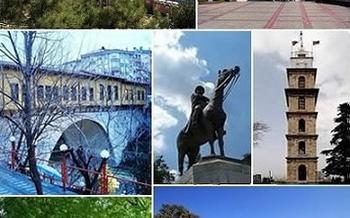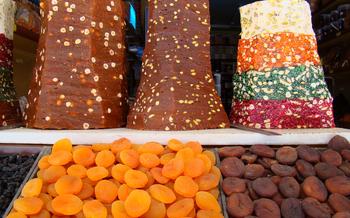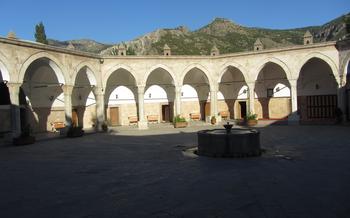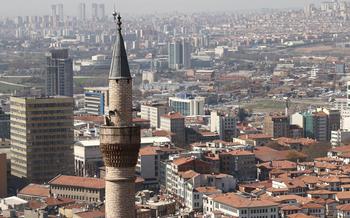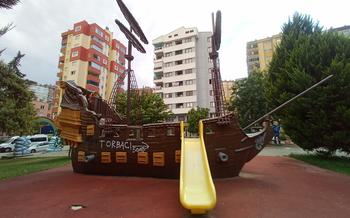
Kadim Cami (Ancient Mosque)
- Erzurum's Kadim Cami: A Journey Through History
- Location and Accessibility
- Architectural Marvels
- A Place of Worship and Community
- Exploring the Interiors
- Courtyard and Ablution Area
- Symbol of Resilience
- Religious Significance
- Unveiling the Minaret
- Prayer Times and Etiquette
- Local Legends and Stories
- Events and Gatherings
- Nearby Treasures
- Photography and Social Media
- Insider Tip: Unveiling Hidden Gems
Erzurum's Kadim Cami: A Journey Through History
The Kadim Cami, also known as the Ulu Cami, stands as a testament to Erzurum's rich heritage and enduring spirit. Built in the 12th century during the Seljuk period, this ancient mosque has witnessed centuries of history unfold within its sacred walls. Its architectural grandeur, cultural significance, and religious importance have made it a beloved landmark and a source of pride for the people of Erzurum.
History of the Mosque
The Kadim Cami was commissioned by the Seljuk Sultan, Tugrul Bey, and constructed between 1179 and 118It is one of the oldest mosques in Anatolia and has undergone several renovations and restorations over the centuries. Despite these changes, the mosque has retained its original Seljuk architectural style and remains a living testament to the empire's legacy.
Architectural Features
The Kadim Cami showcases a blend of Seljuk and Ottoman architectural elements. Its exterior is adorned with intricate stone carvings and decorative tiles, while the interior features a spacious prayer hall supported by massive columns and topped with a magnificent dome. The mosque also boasts a beautiful courtyard with a central ablution fountain and surrounding arcades.
Cultural Significance
The Kadim Cami has played a pivotal role in the cultural and religious life of Erzurum for centuries. It has served as a place of worship, a center of Islamic learning, and a venue for community gatherings. The mosque's architectural beauty and historical significance have made it a popular tourist attraction, drawing visitors from around the world who come to admire its grandeur and learn about its rich history.
Location and Accessibility
The Kadim Cami stands proudly in the heart of Erzurum, a city steeped in history and cultural heritage. Located in the historic Yakutiye neighborhood, the mosque's exact address is Yakutiye Mahallesi, Kadim Cami Sokak. Reaching the Kadim Cami is a breeze, as it is conveniently situated within walking distance from the city center. Visitors can immerse themselves in the vibrant atmosphere of the bustling streets, lined with traditional shops and local eateries, as they make their way towards this architectural masterpiece.
For those arriving by public transport, the mosque is easily accessible via the city's efficient bus network. Several bus lines stop nearby, making it effortless to reach the Kadim Cami from various parts of Erzurum. Once you step off the bus, a short stroll through the neighborhood's charming streets will lead you to the mosque's imposing entrance.
In the vicinity of the Kadim Cami, visitors can embark on a journey of discovery, exploring other landmarks and attractions that showcase Erzurum's rich history and cultural tapestry. The iconic Erzurum Castle, perched majestically on a hilltop, offers breathtaking panoramic views of the city and the surrounding landscapes. The Ulu Cami, another architectural gem, stands testament to the city's Seljuk heritage, captivating visitors with its intricate stonework and serene ambiance.
Architectural Marvels
The Kadim Cami stands as a testament to the architectural ingenuity of its builders. Its unique features, intricate details, and profound symbolism showcase the craftsmanship and artistic vision that went into its construction.
One of the mosque's most striking features is its distinctive dome. Constructed using a complex system of interlocking bricks, it rises majestically above the prayer hall, creating a sense of awe and grandeur. The dome's intricate patterns and geometric designs reflect the mathematical precision and artistic flair of its creators.
Another remarkable aspect of the mosque is its ornate minaret. Towering over the city skyline, the minaret's slender profile and intricate carvings evoke a sense of elegance and grace. Its intricate designs and calligraphy inscriptions showcase the skill and precision of the artisans who crafted it.
The mosque's arched entrances and spacious courtyard further contribute to its architectural charm. The arches, built using precision-cut stone, exhibit intricate carvings and decorative elements that showcase the artistry and attention to detail that went into the mosque's construction. The courtyard, with its serene ambiance and ablution fountain, provides a tranquil space for contemplation and purification before entering the prayer hall.
The Kadim Cami is a true architectural masterpiece that seamlessly blends religious and artistic elements. Its unique features, intricate details, and profound symbolism make it a must-visit destination for anyone interested in history, architecture, and the cultural heritage of Turkey.
A Place of Worship and Community
The Kadim Cami, with its rich history and significant religious status, holds a central position in the spiritual and communal life of Erzurum. As a place of worship, it serves as a sacred space for Muslims to offer their daily prayers. The mosque's spacious prayer hall can accommodate a large number of worshippers, particularly during the congregational Friday prayers, when the community comes together to perform their religious duties.
Beyond its role as a place of worship, the Kadim Cami is also a focal point for community gatherings and events. Its courtyard and surrounding areas provide a welcoming space for Muslims to socialize, exchange ideas, and foster a sense of unity. The mosque hosts religious lectures, workshops, and seminars, aiming to educate and enlighten the community on various aspects of Islam. These events create a vibrant atmosphere, where people can engage in meaningful discussions and strengthen their spiritual bonds.
Additionally, the Kadim Cami serves as a venue for cultural events, such as traditional Islamic music concerts, poetry recitals, and art exhibitions. These events celebrate the rich cultural heritage of Erzurum and provide opportunities for the community to come together and share their talents and traditions. By hosting such events, the mosque plays a vital role in preserving and promoting the city's cultural identity.
Exploring the Interiors
The interiors of the Kadim Cami are a testament to the skill and artistry of its builders. The prayer hall, with its rows of arches and columns, creates a sense of awe and tranquility. The mihrab, the niche indicating the direction of Mecca, is intricately carved and decorated with colorful tiles. The minbar, the pulpit from which sermons are delivered, is a masterpiece of woodworking, with its intricate carvings and inlaid mother-of-pearl.
The walls of the mosque are adorned with beautiful calligraphy and paintings, showcasing the artistic talents of the region. The intricate decorations, including floral motifs and geometric patterns, add to the overall beauty and grandeur of the mosque. The attention to detail and the harmonious blend of colors create a visually stunning interior that is sure to leave visitors in awe.
Courtyard and Ablution Area
The courtyard of the Kadim Cami is a serene and functional space that complements the mosque's overall design. In the center stands a beautifully crafted ablution fountain, where worshippers can perform their ritual cleansing before prayers. The fountain features multiple taps and intricate carvings, reflecting the mosque's attention to detail.
The courtyard design showcases a blend of functionality and aesthetics. Wide, covered walkways line the perimeter, providing shelter from the elements while allowing worshippers to easily access different parts of the mosque. The walkways are supported by elegant arches and columns, creating a harmonious and visually appealing space.
Surrounding the courtyard are several auxiliary structures, including classrooms, offices, and guest quarters. These structures serve various purposes, from providing educational facilities to accommodating visitors and religious scholars. Their architectural style seamlessly blends with the main mosque building, creating a cohesive and unified complex.
Symbol of Resilience
The Kadim Cami has stood the test of time, enduring several devastating earthquakes that have struck Erzurum throughout history. Despite the immense damage caused by these natural disasters, the mosque has been rebuilt and restored, a testament to its enduring strength and resilience. The architectural legacy of the Kadim Cami serves as a reminder of the indomitable spirit of the people of Erzurum, who have repeatedly rebuilt their city and preserved their cultural heritage despite adversity.
Religious Significance
The Kadim Cami holds immense religious significance, attracting pilgrims from across the region. Believed to be built on the site of a former Christian church, the mosque has become a symbol of religious coexistence. It is regarded as a sacred pilgrimage site, where Muslims come to seek blessings and pay homage.
Throughout history, the Kadim Cami has served as a center of Islamic learning and scholarship. Renowned scholars and theologians have graced its halls, imparting knowledge and fostering religious understanding. The mosque's rich history and spiritual aura have made it a focal point for religious education and spiritual guidance.
In the local community, the Kadim Cami plays a vital role in religious life. It serves as a place of worship, where Muslims gather for daily prayers and congregational gatherings. The mosque also hosts religious festivals and events, bringing the community together to celebrate and share their faith. It is truly a cornerstone of spiritual life in Erzurum.
Unveiling the Minaret
The Kadim Cami's minaret stands tall, its slender structure reaching towards the heavens. Constructed with precision and architectural finesse, it is a testament to the skill and artistry of its builders. The minaret's height is awe-inspiring, offering panoramic views of the surrounding city. Its architectural style blends harmoniously with the rest of the mosque, creating a cohesive ensemble that is both visually appealing and architecturally significant.
At the top of the minaret, a balcony encircles the structure, allowing the muezzin to call the faithful to prayer. The call to prayer, echoing through the streets of Erzurum, is a melodious reminder of the mosque's religious significance and its role in the daily lives of the local community. The minaret's presence serves as a beacon of faith, guiding the faithful towards the mosque and inviting them to come together for worship and reflection.
Prayer Times and Etiquette
The Kadim Cami follows the five daily prayer times as prescribed by Islam. Visitors are welcome to join the local community for prayers, but it's essential to be respectful of Islamic customs and traditions.
Before entering the mosque, remove your shoes and place them on the designated shoe racks. It's customary to dress modestly, covering your shoulders and knees. Women should cover their heads with a headscarf or shawl as a sign of respect.
Upon entering the mosque, perform ablution (wudu) at the ablution fountain in the courtyard. This involves washing your hands, face, and feet with water. Once purified, enter the prayer hall and find a spot to pray. Rows of prayer rugs indicate the direction of Qibla, the direction facing Mecca.
During prayer, follow the imam's lead, who will guide the congregation through the various movements and recitations. After the prayer, take a moment to reflect and seek blessings from Allah.
Local Legends and Stories
The Kadim Cami is not only a religious and architectural marvel but also a source of intriguing local legends and stories that have been passed down through generations, adding to its cultural significance. According to one popular tale, the mosque was built on the site of an ancient pagan temple, and its construction was accompanied by supernatural events and signs from the heavens. Another legend speaks of a hidden treasure buried beneath the mosque, believed to be the lost wealth of a long-forgotten kingdom.
The mosque's connection to the community has also inspired stories of resilience and devotion. Tales of individuals who sought refuge within its walls during times of war and hardship are recounted, emphasizing the mosque's role as a sanctuary and a symbol of hope. These stories are not just folklore but a testament to the enduring spirit of the local people and their deep connection to the Kadim Cami.
Events and Gatherings
The Kadim Cami serves as a vibrant hub for religious and community events, fostering a sense of unity and belonging among the local population. During religious festivals, the mosque transforms into a center of celebration, adorned with colorful decorations and bustling with faithful attendees. The annual Mevlid-i Nebi, commemorating the birth of the Prophet Muhammad, draws large crowds to the mosque, who gather for prayers, recitations, and communal meals.
In addition to religious observances, the Kadim Cami also hosts a variety of community events and gatherings. The mosque's courtyard provides a welcoming space for locals to socialize, exchange stories, and participate in cultural activities. Community meetings, workshops, and educational programs are frequently held within the mosque's premises, promoting knowledge sharing and fostering a sense of togetherness.
The Kadim Cami's role as a center for cultural events is particularly noteworthy. The mosque's spacious courtyard often serves as a venue for exhibitions, concerts, and traditional performances. These events showcase the rich cultural heritage of Erzurum and provide opportunities for visitors to immerse themselves in the local traditions and customs.
Nearby Treasures
Beyond the Kadim Cami, the city of Erzurum boasts a wealth of historical and cultural treasures waiting to be discovered. Embark on a journey through the ages as you explore other mosques, landmarks, and museums that tell the story of this ancient city.
Mosques and Landmarks:
-
Ulu Cami: Renowned for its stunning architecture, this mosque is a testament to the city's rich Islamic heritage.
-
Yakutiye Medresesi: Originally a theological school, this historical building now houses the Erzurum Museum, showcasing artifacts from the region's past.
-
Cifte Minareli Medrese: Marvel at the grandeur of this double-minaret madrasa, an architectural masterpiece that has stood the test of time.
Historical Sites:
-
Erzurum Castle: Perched atop a hill overlooking the city, this ancient fortress offers panoramic views and a glimpse into Erzurum's military history.
-
Pasinler Ruins: Explore the remnants of this once-thriving city, including the impressive Pasinler Citadel and the remains of ancient churches.
-
Tortum Lake: Located just a short drive from Erzurum, this picturesque lake is surrounded by stunning scenery, making it a popular spot for nature enthusiasts.
Museums:
-
Erzurum Museum: Delve into the region's rich history and culture at this museum, home to a diverse collection of artifacts, including archaeological finds and traditional handicrafts.
-
Ataturk House Museum: Step into the former residence of Mustafa Kemal Ataturk, the founder of the Turkish Republic, and learn about his time in Erzurum during the Turkish War of Independence.
-
Armenian Church Museum: Discover the history and heritage of the Armenian community in Erzurum through the artifacts and exhibits housed in this museum.
Photography and Social Media
The Kadim Cami presents ample opportunities for photography enthusiasts to capture its architectural wonders. With its intricate details and captivating ambiance, the mosque offers a visual feast for photographers of all levels. Share your experiences and stunning shots on social media, using relevant hashtags to connect with a global audience. Remember to respect the sanctity of the site and avoid using flash photography or creating disturbances during prayer times.
Insider Tip: Unveiling Hidden Gems
As you explore the Kadim Cami, keep an eye out for hidden architectural details and lesser-known areas that offer a glimpse into its rich history. Step off the main tourist path and wander through the surrounding streets to discover smaller mosques, historical buildings, and traditional shops. Engage with the local community by striking up conversations with shopkeepers or visiting nearby cafes to learn more about the mosque's significance in daily life. Remember to be respectful of local customs and traditions, and seek permission before photographing or entering private spaces.


